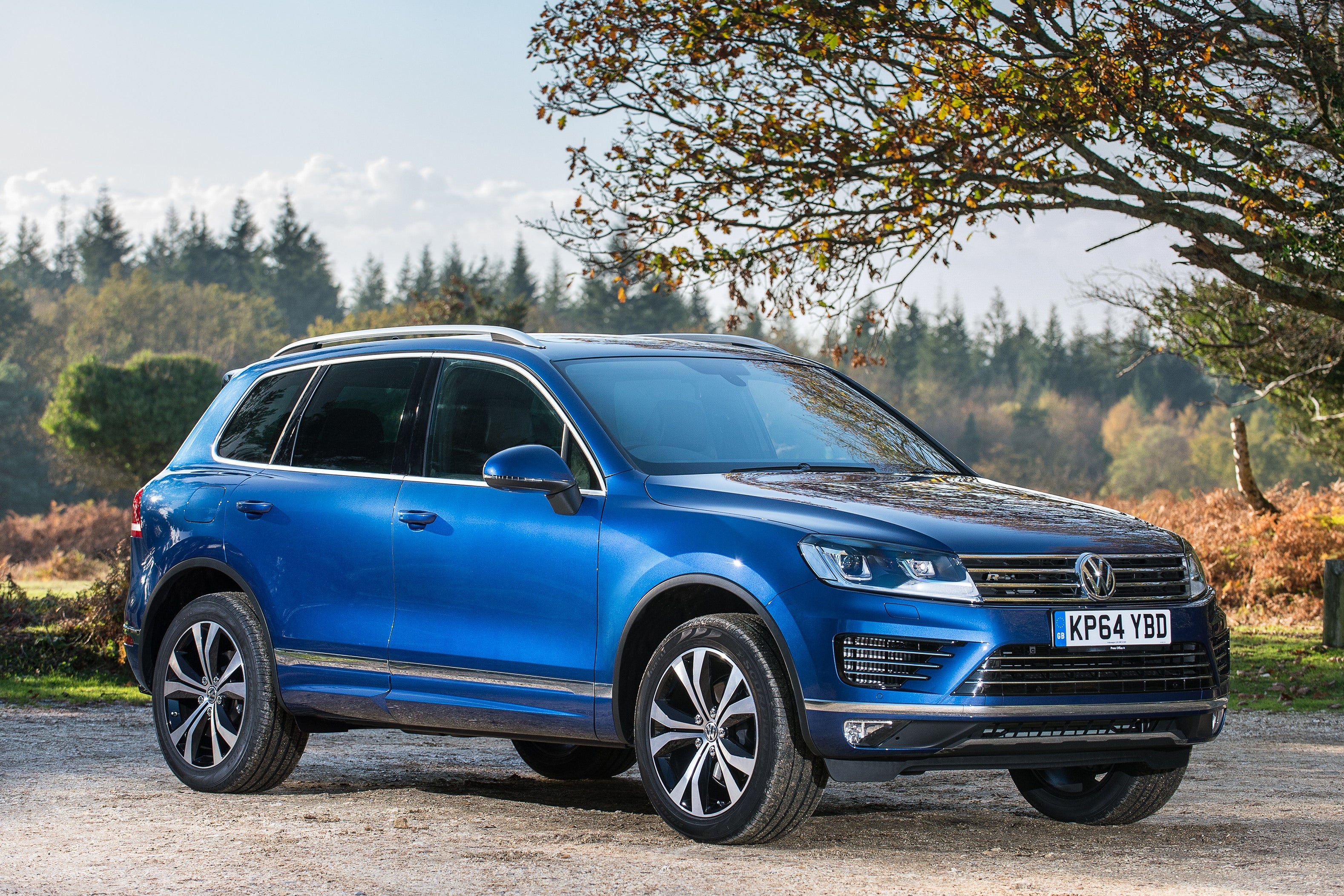Volkswagen Touareg (2010-2018) Review
Written by Andrew Brady
Quick overview
Pros
- Classy, understated image
- Practical and well-equipped
- Value for money compared to other luxury SUVs
Cons
- Some may prefer a sportier alternative
- Rather pointless hybrid version
- Only seats five
Overall verdict on the Volkswagen Touareg
"In this Volkswagen Touareg review we are looking at a sometimes overlooked offering in the crowded luxury SUV market. While the Volkswagen brand is desirable and popular it doesn't seem to stretch to the brand's larger models. A shame, because the Volkswagen Touareg has plenty to offer the big SUV buyer."

The first Touareg showed the world that Volkswagen could build a thoroughly convincing luxury SUV. This second-generation model, released in 2010, continued to build on its predecessor’s many talents, while also fixing some of its flaws. The result was a more well-rounded machine than ever. It’s a perfectly able alternative to a BMW X5 or Mercedes-Benz ML/GLE – and you’ll love how much more you get for your money, too.
This Volkswagen Touareg is a less distinctive but more refined and handsome-looking machine than the original, and it still looks good today. Even the earliest 2010 models seem contemporary: all you need is a non-dating private registration plate. The interior is classy, with a luxury feel that’s a step up even from Volkswagen’s usual high standards.
What helps is the fact that, beneath the surface, the Volkswagen Touareg shared plenty with the Porsche Cayenne performance SUV (and indeed the Audi Q7). Its architecture was designed to take engines with 500PS and more, and set record times around the Nurburgring. Thus even the base 3.0 TDI V6 had more integrity and engineering substance than you might expect.
The Volkswagen Touareg is a five-seater, rather than an SUV that offers the option of a third row of seats. This means its interior is optimised for carrying five and those in the rear seats enjoy thoughtful design and plenty of comfort. The front seats are a nice place to be as well, with a well laid-out, car-like driving position and detail touches such as heated seats even on standard models.
And because the boot doesn’t have to carry folding seats, maximum space is available for luggage. Total capacity is 580 litres with the seats up and it extends further by folding the rear seats. A clever luggage restraining kit allows you to lash down loads so they don’t slide about and drive passengers to distraction.
You won’t necessarily be flinging the Volkswagen Touareg around corners, because it’s not that sort of car. It does handle confidently, though, prioritising a smooth, cushioned ride that lives up to its luxury SUV pretensions. The popular V6 TDI diesel offered ample performance in both of its power outputs, with a rare 4.2 V8 TDI turning the dial up further. There was also a hybrid version, which used a 3.0-litre supercharged petrol engine.
Volkswagen learned a lot with the first Touareg and this knowledge went into making the second-generation version a more robust and reliable machine. It’s much less troublesome and feels a better-built, more solid vehicle – and one that’s likely to age much better. It’s a car you can buy with more confidence today.
The Volkswagen Touareg was gently evolved over its lifetime, with a subtle but worthwhile facelift in 2014. There’s a decent amount of choice, including some very well-equipped versions with genuinely ‘luxury car’ levels of standard kit. However, prices still sit attractively below a more obvious premium-badged SUV.
This is key to the timeless Volkswagen Touareg's appeal, so let’s take you through the range and reveal what you need to know.
Looking for a used car for sale? We've got 100s of Volkswagen Approved Used Cars for Sale for you to choose from, including a wide range of VW Touareg cars for sale. If you're looking for the newer version, you need our Volkswagen Touareg (2018-) review.
Is the Volkswagen Touareg right for you?
The Volkswagen Touareg is a very easy-going premium SUV choice that’s more discreet than some others in this burgeoning sector. That alone is enough for some to prefer it over louder, shoutier alternatives. It’s very refined, smooth and plush to drive, and it gives off an understated, classy image that’s an appealing contrast to some of its rivals.
It’s roomy, too, and will be a lovely family five-seater if you’re after something a bit different to the norm. The boot is big and standard equipment levels reflect the upmarket profile Volkswagen intended for it. Better reliability than the first Volkswagen Touareg is reassuring as well.
What’s the best Volkswagen Touareg model/engine to choose?
The 3.0-litre TDI V6 diesel dominated sales when new and it’s still the best engine to choose today. It sounds pleasant, runs smoothly and offers ample response to the accelerator. You really don’t need the step up to the V8 TDI, although those who’ve tried it might easily be lured in.
The petrol alternative is the Volkswagen Touareg Hybrid. This pairs an already-powerful 3.0-litre supercharged V6 petrol engine with an electric motor, allowing pure electric driving at lower speeds. It’s curiously fast and potent for a machine focused on economy, we feel.
As for variants, they’re all nice, even the basic SE. The Escape is an off-road-focused version, with a more rugged four-wheel-drive system and added underbody protection, while R-Line takes the alternative route and dials up the sportiness with wheelarch extensions and 20-inch alloys.
What other cars are similar to the Volkswagen Touareg?
If you’re after a more in-your-face SUV, you might prefer something like a BMW X5 or Audi Q7. Alongside a Mercedes-Benz though, the Touareg is an interesting option that gives you much more for your money. It’s comfier and more car-like than a Land Rover Discovery and classier than a Volvo XC90.
It’s similar in size to a Range Rover Sport, but costs much less (and is rather more dependable). Or if you’re feeling really brave, you could look to its near-sibling, the Porsche Cayenne, and discover just what those underpinnings are capable of.
Comfort and design: Volkswagen Touareg interior
"Comfort and design is one of the Volkswagen Touareg’s strongest suits. The interior is exceedingly appealing, with a luxury appearance as soon as you open the door. It’s more Bentley than Volkswagen, with beautiful chrome-detailed switches and dials, watch-like instruments and, on some versions, wood dashboard inlays that are much more convincing than you may expect."
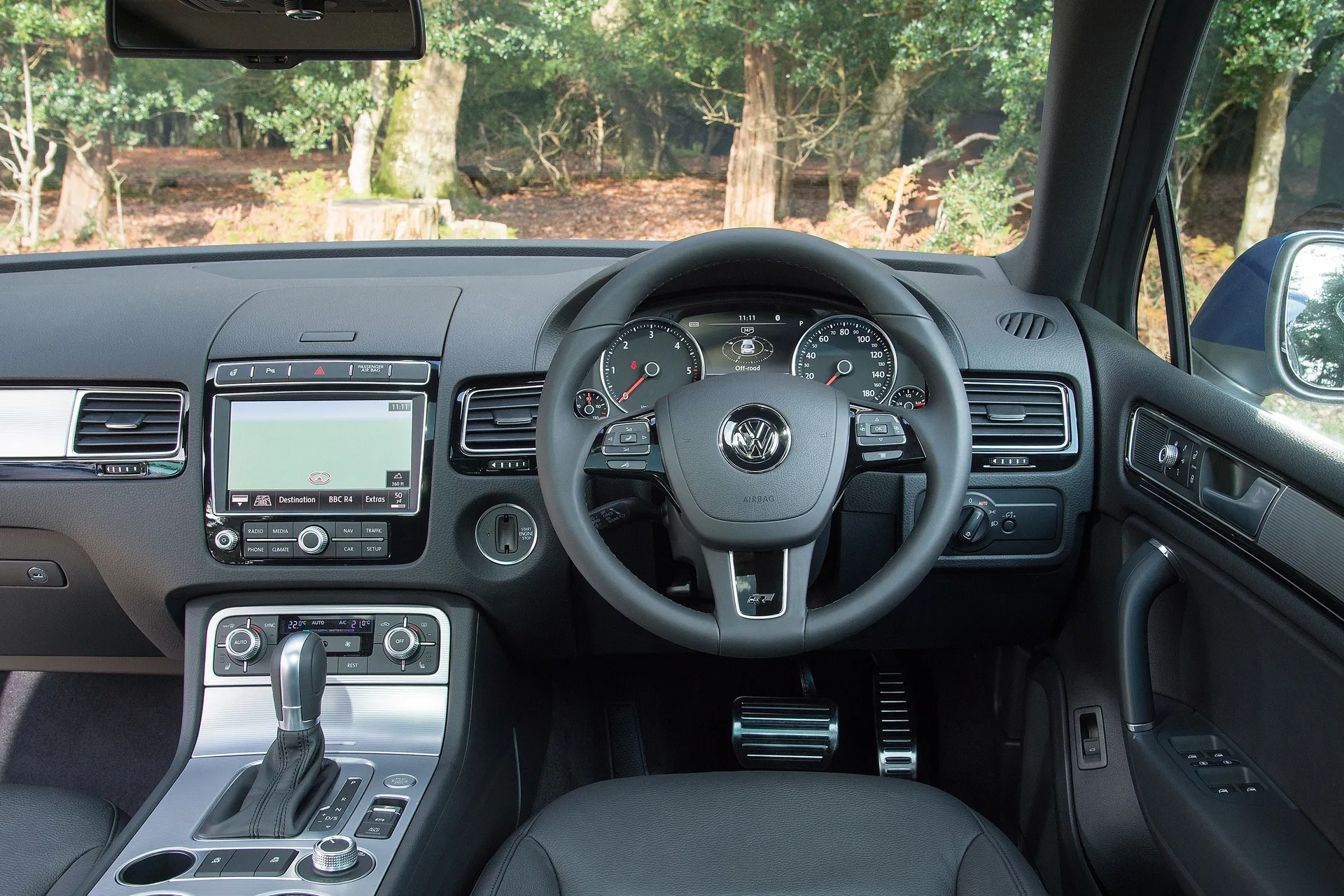
It’s a relaxed and understated design. Extreme angles and angrily sweeping trim strakes are certainly not the name of the game here. Rather, it’s a soothing place that, when you pull the door shut and hear that reassuring click to seal you off from the world, instantly takes your heart rate down a notch or two.
The seats are plush and ample. They’re supportive, but focused more on comfort, rather than clamping you in place to go barrelling around corners. If you’re after that sort of thing, the R-Line chairs are a bit more bolstered, but it’s still relative.
In the centre of the dashboard is a reasonable-size touchscreen, flanked by metal-framed air vents either side. Below that is a heater panel familiar to many a Volkswagen owner. There’s no fuss or fanfare, just solid and simple design that’s finished to the highest standard. We love holding the feel-good steering wheel, too.
It feels comfortable in the rear as well. Back-seat passengers will know they’re not just in any old Volkswagen, but one developed by the firm’s upmarket line. It’s more cosseting, more comfortable, and the design again exudes a luxury touch that makes it feel more special than other Volkswagens.
Quality and finish
Quality is a notch above even the high standards normally found in Volkswagens. The trims and plastics seem a bit more Audi- or Porsche-like, which is no great surprise given how much the Volkswagen Touareg shares with those more premium SUVs beneath the surface. It feels more like a quiet, luxury cocoon, with damped controls and satin-finish surfaces.
There’s great attention to detail: we love the tactile controllers on the centre console, and the little metal inlays in the electric window and door mirror switches. The precision-fit metal strip on the door panel is laser-like in accuracy, and even the infotainment screen gets its own metal finishing surround. Each of the instruments sits within its own chrome ring, with a high-resolution colour display positioned within.
The leather upholstery is soft and plush, adding to the quality feel. And because it’s a Volkswagen, it’s all built to last, so should wear well over the years. You shouldn’t hear many rattles or buzzes over time. It’s far too cultured a car for that.
Infotainment: Touchscreen, USB, nav and stereo in the Volkswagen Touareg
All Volkswagen Touaregs came fitted with an 8.0-inch touchscreen, which featured standard sat-nav, DAB digital radio and Bluetooth. It’s a system familiar from other Volkswagen models, and is generally quite straightforward to use – not BMW iDrive-slick, but easy to figure out once you’ve got used to the combination of touchscreen jabs, knob twiddles and shortcut keys.
Navigation guidance is replicated in the screen between the instruments, so you don’t have to keep glancing down at the centre console, which is handy. That second screen can be toggled to show a range of other information, too. In the Volkswagen Touareg Hybrid, it can show where power is flowing.
Facelifted cars from 2014 received an enhanced nav system that was even crisper and better-looking. Google Earth and Google Street View maps were included, which look amazing.
A premium Dynaudio sound system was optional. This was a good-value £1,000 option when new, so you might find it fitted to a few second-hand models. The system delivered plenty of power, particularly in the mid-range, making Volkswagen Touareg drivers’ favoured Radio 4 seem more vivid and audible than it usually is when driving. Look out for the Dynaudio branding on the tweeter speakers near to the door handles.
Space and practicality: Volkswagen Touareg boot space
The Volkswagen Touareg is a big vehicle, more than 4.8 metres long and nearly two metres wide. And it’s a straight five-seater. So, yes, there is plenty of space inside to keep everyone happy. As is common with German cars, the driver’s seat has a huge range of adjustment, particularly fore and aft. With a fully adjustable steering wheel, it’s easy to find a good driving position no matter in what proportion your legs and arms are. The layout itself also feels less van-like than some SUVs.
The Volkswagen Touareg gives a good view out, courtesy of sitting over 1.7 metres tall. It’s a commanding feeling that seems safe and powerful. The lofty view out of the side windows is also practical, as you can see so much more, while a tall roof gives an airy feel (enhanced further on those models fitted with the panoramic glass roof).
Rear-seat passengers have nothing to fear. It’s a bit of a climb up into the Volkswagen Touareg, but access is wide and, once there, occupants have ample room for feet, knees, arms and heads. The rear seat base is particularly comfortable, and it’s a very relaxing place to while away the motorway hours. The kids will love parents playing chauffeur.
The voluminous boot is 580 litres in size with the seats up. It’s an easy-to-load space with a flat load bay, so you can simply slide heavy items in and out. It’s also wide, and the shape is nicely squared off, so you won’t get big objects half-way in and then find there’s something blocking their way. Folding the rear seats down extends it to 1,642 litres, which is almost as big as a large estate car. A power-assist electric tailgate is a handy extra.
We also like the fact it has rails down either side, which you can use to lash things down using the load securing kit. This comprises straps, nets and other practical gadgets to keep things in place. Below the boot is a space-saving spare wheel. The rear seat also slides back and forth, so you can vary luggage space with rear legroom – and the backrest reclines, so passengers can lie back and snooze if there’s nothing much in the boot.
The Volkswagen Touareg has two ISOFIX mounting points, on each of the outer rear seats, and you could choose an optional front passenger seat Isofix mount, too. The front airbag can be disabled, naturally.
The Volkswagen Touareg dimensions are 4801mm long, 2208mm wide and 1709mm tall.
Handling and ride quality: What is the Volkswagen Touareg like to drive?
"Regular Volkswagen Touaregs drive in a reassuring, safe and grown-up way. All have four-wheel drive as standard, guaranteeing a good level of security in all weathers. You buy an SUV for its all-round ability and the security of being able to drive out of snowstorms and through rivers. The Volkswagen Touareg doesn’t disappoint, and even has a few electronic aids to make mild off-roading a far from daunting affair."
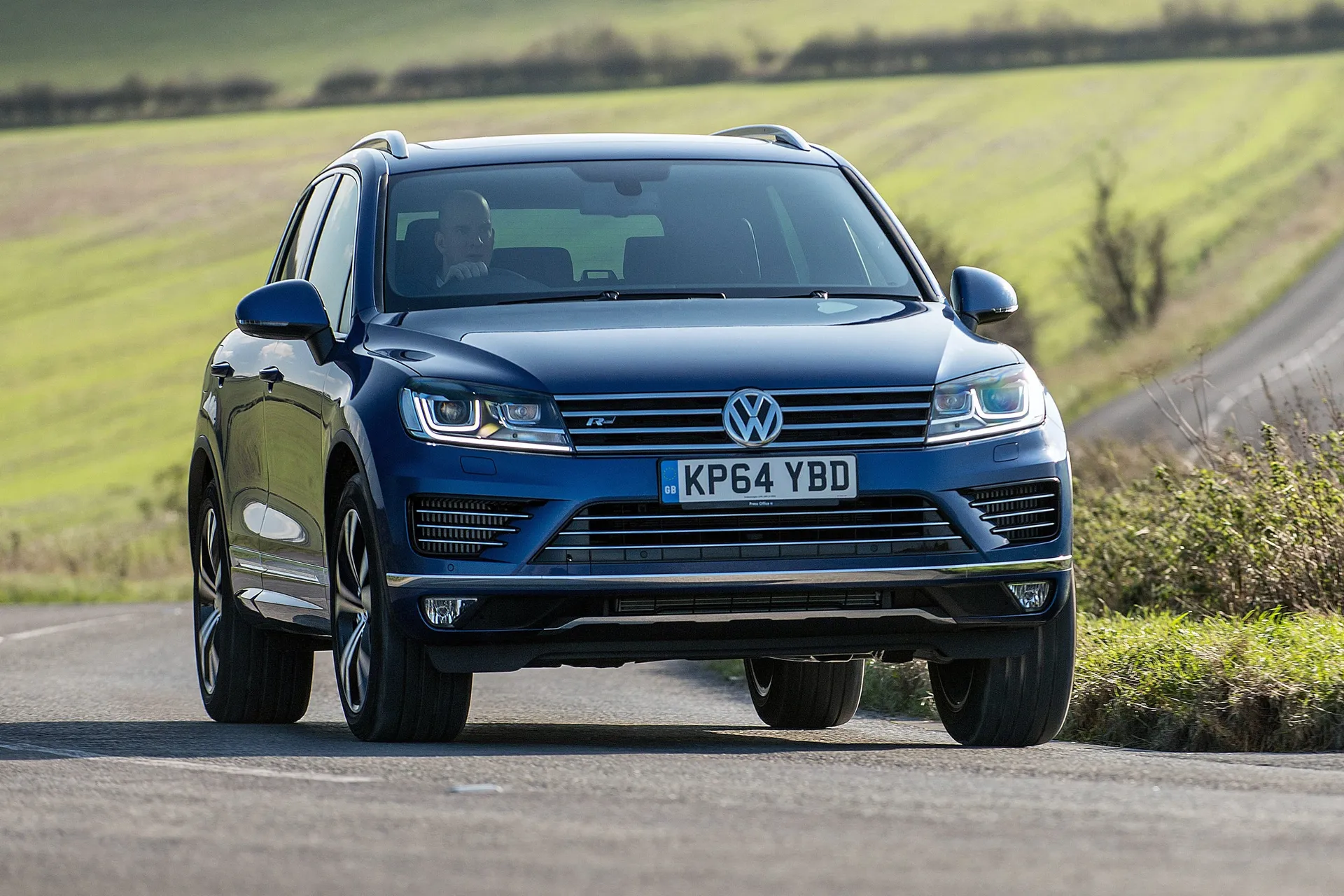
The Escape model turns things up a notch here. It is optimised for more demanding off-road use, with more underbody protection, a locking rear differential and an electronically-controlled centre differential lock. Even the fuel tank is larger, up to 100 litres (standard is 85 litres), for those wild forays deep into the wilderness.
Back on the highway, the Volkswagen Touareg is a low-effort drive, with light steering and stable handling. It’s nowhere near as sporty as a Porsche Cayenne, but at the same time is anything but wallowy and boat-like. The further benefit of this approach is a very pleasing and comforting ride quality. It quietly soaks up bumps without fuss, giving a cushioned and luxurious feel not unlike Range Rovers and Bentleys.
Some models offered even more comfort. Optional air suspension really did give a luxury car ride, with the same waft-along feel you imagine the Queen enjoys. It’s genuinely cosseting – and the added benefit for those who tow is the guarantee of no saggy bottoms thanks to the built-in self-levelling function. No matter how heavily the Volkswagen Touareg is laden, it will stay on the straight and level.
What engines and gearboxes are available in the Volkswagen Touareg?
The core engine in the Volkswagen Touareg, the one you’ll see most often, is the 3.0-litre TDI V6 diesel. At launch, it came in two power outputs: 204PS and 245PS. Even the less powerful version took this big SUV from 0-62mph in 8.5 seconds. The 245PS variant cuts this by almost a second. Both engines are silky-smooth and creamy, with an upmarket feel.
They also both have lots of torque – more than 540Nm, in fact. Floor the accelerator and the Volkswagen Touareg feels genuinely muscular. On the move, it responds strongly and picks up speed without fuss. You’d never believe it weighs over 2.1 tonnes.
The amusing alternative at launch was the 4.2-litre V8, a riotous engine with rip-roaring performance, but was expensive and therefore a bit of a rarity. The Volkswagen Touareg Hybrid supercharged V6 was amusing too, and it could run silently on electric power at slow speeds. Most made good use of its nearly 400PS power output,though, which negated any possible fuel savings.
All Volkswagen Touaregs came with an eight-speed automatic gearbox. This is the ZF unit used in so many other premium cars, and it’s as flawless here as everywhere else.
After the facelift, the range was rationalised to just the two V6 TDI engine options. The higher-power version now had even more power, 262PS, giving 0-62mph in 7.3 seconds. They also had ‘green’ Bluemotion Technology features such as SCR selective catalytic reduction.
Refinement and noise levels
The Volkswagen Touareg is without doubt one of the smoothest, quietest-running SUVs you can get for the money. Noise levels are extremely low, barely lifting above a whisper even when you start the engines. In town, it oozes luxury and feels like a sanctuary away from the world.
The ride is plush and doesn’t grumble over bumps: it cushions away road harshness, so you’re barely aware of it in practice. Models with air suspension are even better here, with the high-tech setup giving a luxury car experience in terms of refinement, too.
The V6 engines are so muscular, you rarely have to rev them hard. They err a little towards clatteriness when you do, but you don’t have to do it often, so it shouldn’t annoy. The Hybrid is literally silent when running as an EV in town, but noisier than the TDIs in daily use, because it revs that bit higher. As for the V8, it sounds so lovely, you simply wish you could hear more of it.
Safety equipment: How safe is a Volkswagen Touareg?
The Volkswagen Touareg was launched before the time when Euro NCAP routinely tried to crash-test every single car on sale. It therefore doesn’t have a star safety rating, but we have no doubt it would perform well, such is the integrity clearly in evidence.
Six airbags were standard, as was electronic stability control, while anti-theft safety kit included an alarm and immobiliser. There was also a standard driver alert system, which pinged to warn you when it detected any dangerous driver tiredness.
Four-wheel drive is an obvious safety feature, giving more secure traction in all weathers. With the UK’s increasingly varied winter weather – and frequent summer floods – this is a feature always working for you in the background. Models with air suspension have adjustable ride height, too.
Radar cruise control – called Automatic Distance Control – is optional. This keeps a set distance from the vehicle in front, which can be easily adjusted depending on how many people cut you up. With the 2014 facelift, it was enhanced, with standard city emergency braking and a clever auto pull-away function for use in city traffic.
Automatic post-collision braking was standardised in 2014. Safety studies showed that in high-speed collisions, drivers’ feet can get bumped off the brake pedal after the first impact – yet the vehicle will still be moving. Post-collision braking automatically applies the anchors, so the car comes to a complete halt.
MPG and fuel costs: What does a Volkswagen Touareg cost to run?
"Let’s not dwell on the 31.0mpg fuel economy of the V8 TDI. Instead, look at the 34.4mpg of the Hybrid – it’s barely any better, and that’s the price you pay for fitting a powerful 3.0 TSI V6 to a supposed fuel-saving model."
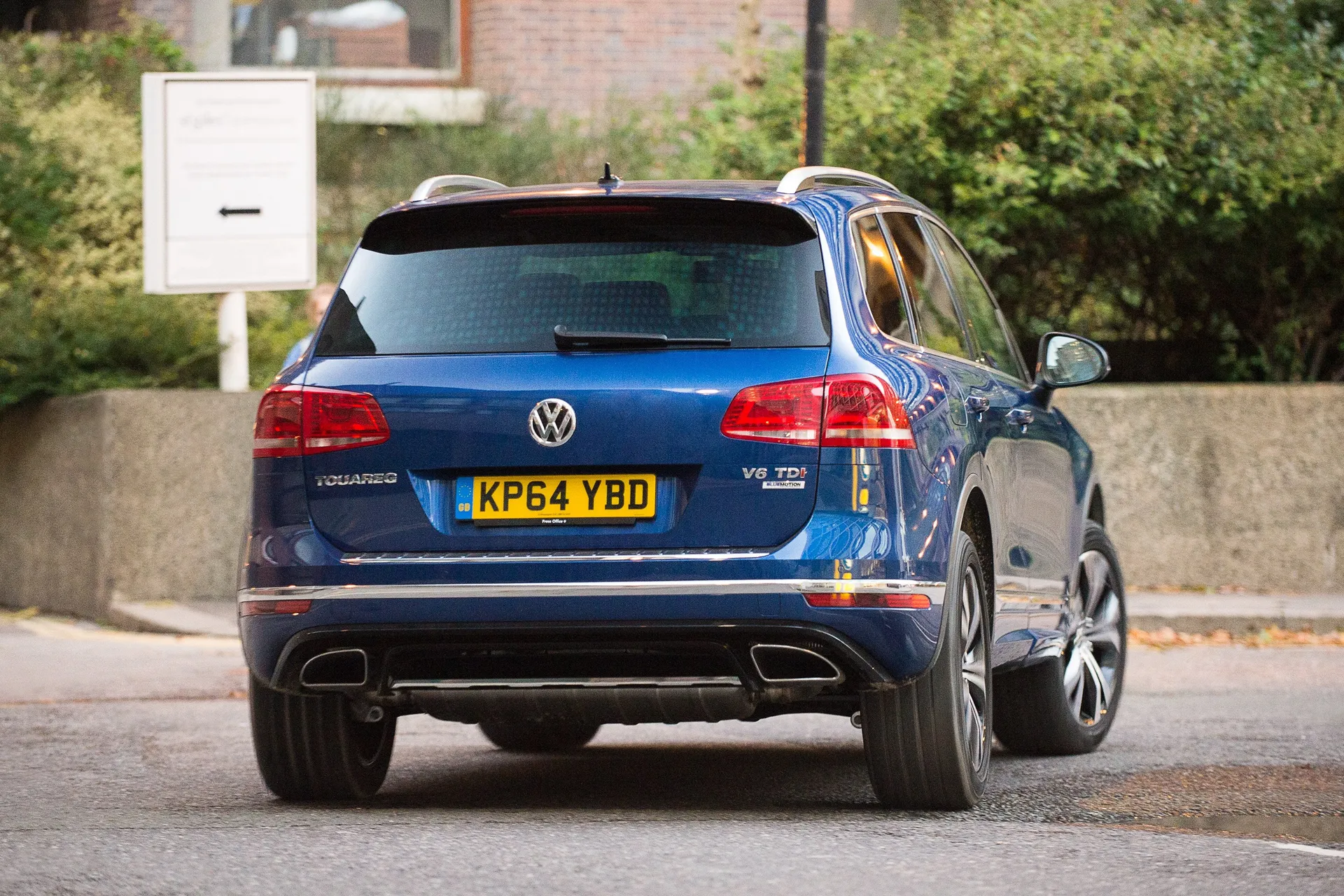
That’s why both of these versions are rare in the UK. The diesels were far better. The 3.0 TDI V6 204 managed over 40mpg, and even the extra power of the 245PS version only reduced this by less than 1mpg, to 39.2mpg.
Following the 2014 facelift and range rationalisation, both V6s gained engine stop-start as standard, as part of the Bluemotion Technology suite of fuel-saving tech. Battery regeneration saved a few more millilitres of fuel on the move, too: it’s only recharged when the car is braking.
They became even more fuel-efficient as a result. The 3.0 TDI 204 now averaged 42.2mpg and the 3.0 TDI 262 could do as much as 41.5mpg, keeping fuel costs correspondingly low for such a large and luxurious machine.
How reliable is a Volkswagen Touareg?
The Volkswagen Touareg scored an impressive 9.33 out of 10 for reliability in the HonestJohn.co.uk Satisfaction Survey, making it one of the better-performing Volkswagens of this generation and likely reflects the shared parentage with its more expensive Audi and Porsche cousins.
As a brand Volkswagen also finished a solid 10th out of 30 manufacturers overall in the same survey.
Insurance groups and costs
TDI V8 models were rated as high as group 46 for insurance. That’s almost unheard of for a Volkswagen, and is evidence of how far upmarket they were pitched. This is an insurance rating normally associated with Porsches and Audis, not Volkswagens. The Volkswagens Touareg Hybrid wasn’t much better, mind: it was rated group 45, which is slightly staggering for, again, a supposed green machine.
Other versions were more affordable. The entry-level 3.0 TDI 204 SE came in at group 35 from launch, although it did step up rather notably in 245PS guise – by no fewer than five insurance bands, to group 40. If you’re looking at both versions, make sure you get insurance quotes beforehand, to make sure there are no nasty surprises when it comes to costs.
VED car tax: What is the annual road tax on a Volkswagen Touareg?
Petrol engines always put out slightly higher CO2 emissions – the basis for VED (road tax) – than diesels. The Touareg Hybrid has a 193g/km CO2 rating, which places it in band J for VED – and because it’s officially classified an alternative fuel vehicle, there’s a £10 saving on the annual bill, taking it down to £295 a year.
The TDI 204 emits 184g/km CO2, for annual VED of £265 a year. The TDI’s higher CO2 emissions push it up from band I into band J, for an annual bill of £305. And the V8 costs a hefty £565 a year, because it emits 239g/km CO2.
Post-facelift models with Bluemotion Technology enjoy a further cut in CO2 emissions, which places them both in band H for VED, costing £240 a year.
Remarkably, latter models registered after April 2017 will be cheaper to tax - you'll pay a modest £165 for most versions.
How much should you be paying for a used Volkswagen Touareg?
"Around £7,000 is the starting point for a 3.0 V6 TDI, although you’ll likely be looking at a six-figure mileage for that money. Upping your budget to £11,500 secures you a similar car with plenty of life left. "
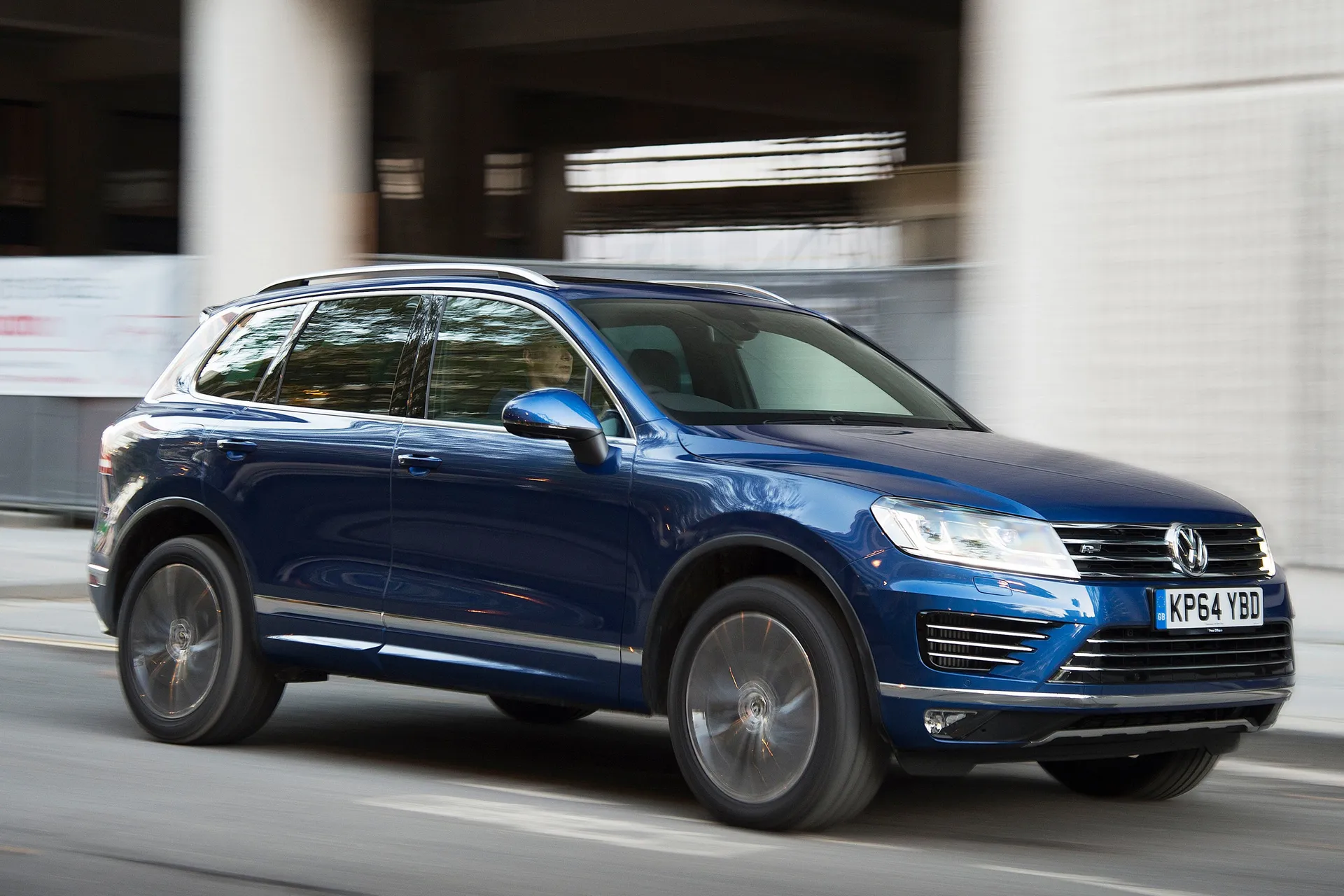
The absolute top price for a Touareg of this generation is around £25,000, which buys a late 2016 or 2017 model with low miles. If that sounds steep, remember it’s scarcely more than half what you’ll pay for a new Touareg.
Amazingly, we found just one Hybrid for sale at the time of writing: a sign, perhaps, of the car’s inherent flaws. However, if you’re dead-set against diesel – or live in a city such as Bristol that aims to ban diesel altogether – its sheer rarity commands a premium. The 2013 car we found was priced at £24,000.
Trim levels and standard equipment
You’re guaranteed a very healthy level of standard equipment with the Volkswagen Touareg. From launch, entry-level Volkswagen TouaregSE models had 18-inch alloys, leather upholstery with heated front seats, two-zone climate control, folding door mirrors, auto headlights and rain-sensing wipers, sat-nav, parking sensors and hill-start assist. The off-road-biased Volkswagen Touareg Escape models added more rugged styling and Land Rover-style adjustable off-road traction control.
Wheels grew to 19 inches on Volkswagen Touareg Altitude variants, which also had heat-insulating glass, sports suspension, standard Bluetooth and steering wheel paddle shifters. The Volkswagen Touareg Altitude V8 had 20-inch alloys, xenon headlights, enhanced Vienna leather and electric-adjust seats that included built-in air-cushioned side bolsters. The Volkswagen Touareg Hybrid was an alternative take on SE with 19-inch alloys, Vienna leather, xenon headlights, Bluetooth and electric seats.
Volkswagen Touareg R-Line trim followed in 2013. This featured 20-inch alloys, R-Line front and rear bumpers, LED running lights, a panoramic glass roof and an R-Line-branded interior. Following the facelift, SE, Escape and R-Line grades were carried over.
Ask the heycar experts: common questions
Which is bigger, the Volkswagen Tiguan or Touareg?
Is the Volkswagen Touareg a luxury car?
Is a Volkswagen Touareg bigger than an Audi Q7?
Get our latest advice, news and offers
Keep me updated by email with the latest advice, news and offers from heycar.
By submitting you agree to our privacy policy
